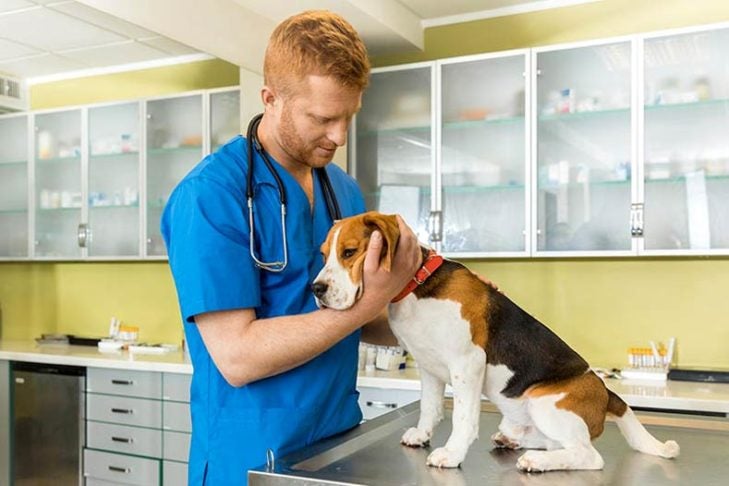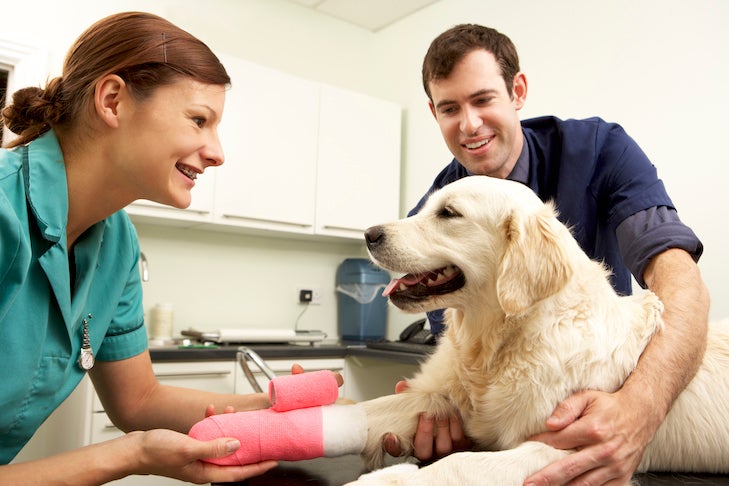Imagine a mild sedative before leaving home, a bandana sprayed with calming scents, a bunch of bacon snacks, and skipping the hour-long frenzy in the waiting room. From classical music wafting across the sign-in desk to licking peanut butter off the wall to act as a distraction from getting a shot, your dog’s typical freak-out scene at the veterinarian’s office is about to change for the better.
Say goodbye to wrestling your dog through the door and say hello to Fear Free doctors’ visits.
Innovation + Intervention
Thinking inside the black boxes of the canine and feline minds, veterinarian Marty Becker launched the Fear Free pets program in April 2016. Designed to give dogs and cats better ways to cope with trips to the doctor, Becker employs practical interventions to keep anxiety at bay before it escalates to full-blown aggression.
These include:
- examining dogs on nonslip bath or yoga mats
- giving dogs and cats separate sides of the clinic
- dousing the staff, exam rooms, and stethoscopes with Adaptil, a product that mimics the security pheromone a mother dog gives off after delivering her puppies.
“When dogs are sick, they’re in pain, and they associate a negative experience with the place and the person trying to help them,” says Becker. “This affects their whole life. For a puppy or a dog coming into the clinic where the last visit was a bad one, nothing makes sense.”
What sparked the interest?
In 2009, while attending the Alberta Veterinary Medical Association Conference, Becker heard veterinary behaviorist, Karen Overall, of the University of Pennsylvania College of Veterinary Medicine, present a keynote address about fear, anxiety, and stress.
“She outlined how these feelings not only affect dogs physically, but can cause severe, emotional damage,” recalls Becker. “I had no idea that what I thought was collateral during a vet visit could actually cause permanent damage.”
Becker believed it was in his wheelhouse to help alleviate it. It’s a win-win, because when dogs aren’t stressed, their owners aren’t stressed, and the employees aren’t stressed.
“In vet school, we learn about fixing broken bones, performing surgeries, and giving medicine, but they don’t address what the dog feels,” says Becker.

School for Soothing
For Julie Reck, DVM, owner, and founder of the Veterinary Medical Center of Fort Mill, South Carolina, owning a business and leading people without training was a challenge after vet school. “I acquired skills from working on the job, but the Fear Free course videos show technicians who draw blood or insert catheters how to score fear, anxiety, and stress on a 1 to 5 scale before the dog is out of control.”
According to Becker, 75,000 individuals in the U.S. have taken the Fear Free course. This includes 45 percent of veterinarians, 45 percent of nurses, and 10 percent of receptionists, kennel attendants, assistants, and practice managers who are Fear Free certified. Of 30 veterinary schools in the U.S., 16 require students to become Fear Free certified before graduation.
For certification, a veterinary professional must complete an eight-module online course and pass an exam following each module. A Fear Free certified practice requires a minimum of two staff members who complete the program. Certification lasts for three years.
“We have not been taking care of our dogs’ emotional health,” says Dr. Natalie Marks, a 20-year veterinarian, whose Blum Animal Hospital, in Chicago, has added the Fear Free program to her practice. “We need to understand their body language and how to prevent triggers of anxiety.”
Make a Plan
For a successful visit, veterinarians and technicians may need to rethink the appointment. Recognizing when a dog revs up his anxiety level helps alert the veterinarian to find a gentler, calmer way to approach the patient.
“It may mean going into a different room or outside for the exam, or stopping the appointment and giving the owner some medication to take home and give the dog before returning another day,” says Becker.
No one likes dealing with an aggressive dog, least of all the five or more assistants whose job entails holding down a dog who resists a rudimentary procedure, such as ear cleaning or nail trimming.
When Nala, a 5-month-old German Shepherd Dog, walked into the Bloomsburg Veterinary Hospital in Bloomsburg, Pennsylvania, for the first time she barked at anyone who approached her owners. “We encouraged them to bring Nala in for social visits,” says Stacey Wheeler, Bloomsburg’s client care supervisor. “We gave her treats and let her smell our hands so she realized we wouldn’t hurt her family. Now she’s excited to come in.”

Room Where It Happens
Although the program sounds ideal for a mid-to large-size practice with space to renovate their floorplans and spend more time with patients, what can an older, one-veterinarian office with fewer resources accomplish?
“Before attending LSU School of Veterinary Medicine, I worked at a longstanding small dog-and-cat clinic with a strip mall built up around it,” says Vardui Rose Khorikyan, DVM. “There was no room to add a bigger waiting room or a separate entrance for cats.”
For quick fixes, the Fear Free program recommends finding creative, inexpensive ways to make it work. Letting a patient wait in an empty hallway or behind a chair in a quiet corner of the business office may not win any room-with-a-view awards, but these solutions may settle a dog’s inner scaredy-cat. Another smart design idea is to create room barriers in the waiting room by setting up a row of plants or a wall of shelves.
Becker advocates longer appointment times to take detailed histories; rate fear, anxiety, and stress scores; record steps taken to reduce anxiety; and what treats or methods the dog responded to best.
“Practitioners worry they won’t have enough time to spend with their patients, but in the long run they save the dog, the owner, the staff, and themselves,” says Marks.
Before the Visit
Want to give peace a chance at the veterinarian’s office if it’s not a Fear Free practice?
If so, prepare in advance for a serene appointment by following these tips:
Condition your dog to frequent short car trips. Provide positive experiences and reward with treats.
Your dog should ride in a carrier sitting on a level surface in the car or secured in a comfortable safety harness.
- Make a few quick drop-ins to the clinic. Enter and ask the receptionist to greet your dog, hand out a treat, and leave. These trips build a bond with the office.
- Remain patient and keep a low, calm voice. If you’re feeling apprehensive, your dog will pick up your stress.
- To help your dog relax on the way to an appointment, ask the veterinarian about giving your dog Adaptil. Spray the calming supplement on a towel and place it inside and over the top of the crate or around the harness.
- For a dog with severe emotional distress, inquire about prescription medication to take the edge off, but not knock her out.
- Skip a long or crowded wait in the lobby. Remain in your car and ask the receptionist to call or text you when an exam room opens.
Originally published in the March/April 2020 issue of AKC Family Dog
Have a non-urgent question for a veterinarian? AKC Vetline is a live, 24/7 service staffed by licensed veterinary staff and pet professionals. Get unlimited access to answers about your pet’s health and wellness whenever and wherever you need it from a source you know you can trust.
This article is intended solely as general guidance, and does not constitute health or other professional advice. Individual situations and applicable laws vary by jurisdiction, and you are encouraged to obtain appropriate advice from qualified professionals in the applicable jurisdictions. We make no representations or warranties concerning any course of action taken by any person following or otherwise using the information offered or provided in this article, including any such information associated with and provided in connection with third-party products, and we will not be liable for any direct, indirect, consequential, special, exemplary or other damages that may result, including but not limited to economic loss, injury, illness or death.


